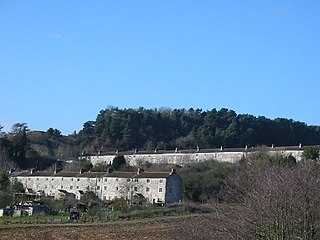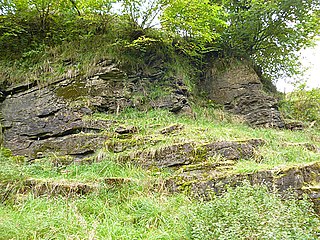Related Research Articles

The Carboniferous is a geologic period and system of the Paleozoic that spans 60 million years from the end of the Devonian Period 358.9 million years ago (mya), to the beginning of the Permian Period, 298.9 mya. In North America, the Carboniferous is often treated as two separate geological periods, the earlier Mississippian and the later Pennsylvanian.
The PaleozoicEra is the first of three geological eras of the Phanerozoic Eon. Beginning 538.8 million years ago (Ma), it succeeds the Neoproterozoic and ends 251.9 Ma at the start of the Mesozoic Era. The Paleozoic is subdivided into six geologic periods :

Hibbertopterus is a genus of eurypterid, a group of extinct aquatic arthropods. Fossils of Hibbertopterus have been discovered in deposits ranging from the Devonian period in Belgium, Scotland and the United States to the Carboniferous period in Scotland, Ireland, the Czech Republic and South Africa. The type species, H. scouleri, was first named as a species of the significantly different Eurypterus by Samuel Hibbert in 1836. The generic name Hibbertopterus, coined more than a century later, combines his name and the Greek word πτερόν (pteron) meaning "wing".

Arthropleura is an extinct genus of massive millipedes that lived in what is now North America and Europe around 345 to 290 million years ago, from the Viséan stage of the lower Carboniferous Period to the Sakmarian stage of the lower Permian Period. The species of the genus are the largest known land invertebrates of all time, and would have had few, if any, predators.

Dendrerpeton is a genus of an extinct group of temnospondyl amphibians. Its fossils have been found primarily in the Joggins Formation of Eastern Canada and in Ireland. It lived during the Carboniferous and is said to be around 309–316 million years of age, corresponding to more specifically the Westphalian (stage) age. Of terrestrial temnospondyl amphibians evolution, it represents the first stage. Although multiple species have been proposed, the species unanimously recognized is D. acadianum. This species name comes from “Acadia” which is a historical name for the Nova Scotia region as a French colony. It refers to the location of the coal field at which the fossil was found.

Writhlington SSSI is a 0.5 hectare geological Site of Special Scientific Interest near the town of Radstock, Bath and North East Somerset, notified in 1992.

The Bear Gulch Limestone is a limestone-rich geological lens in central Montana, renowned for the quality of its late Mississippian-aged fossils. It is exposed over a number of outcrops northeast of the Big Snowy Mountains, and is often considered a component of the more widespread Heath Formation. The Bear Gulch Limestone reconstructs a diverse, though isolated, marine ecosystem which developed near the end of the Serpukhovian age. It is a lagerstätte, a particular type of rock unit with exceptional fossil preservation of both articulated skeletons and soft tissues. Bear Gulch fossils include a variety of fish, invertebrates, and algae occupying a number of different habitats within a preserved shallow bay.

Diplichnites are arthropod trackways with two parallel rows of blunt to elongate, closely spaced tracks oriented approximately perpendicularly to the mid-line of the trackway. The term is more often used for the ichnofossils of this description; however, similar trackways from recent arthropods are sometimes given this name as well.

Adelophthalmus is a genus of eurypterid, an extinct group of aquatic arthropods. Fossils of Adelophthalmus have been discovered in deposits ranging in age from the Early Devonian to the Early Permian, which makes it the longest lived of all known eurypterid genera, with a total temporal range of over 120 million years. Adelopththalmus was the final genus of the Eurypterina suborder of eurypterids and consisted the only known genus of swimming eurypterids from the Middle Devonian until its extinction during the Permian, after which the few surviving eurypterids were all walking forms of the suborder Stylonurina.

Arthropods are invertebrates that are a part of the phylum Arthropoda. They possess an exoskeleton with a cuticle made of chitin, often mineralised with calcium carbonate, a body with differentiated (metameric) segments, and paired jointed appendages. In order to keep growing, they must go through stages of moulting, a process by which they shed their exoskeleton to reveal a new one. They are an extremely diverse group, with up to 10 million species.

The Allegheny Group, often termed the Allegheny Formation, is a Pennsylvanian-age geological unit in the Appalachian Plateau. It is a major coal-bearing unit in the eastern United States, extending through western and central Pennsylvania, western Maryland and West Virginia, and southeastern Ohio. Fossils of fishes such as Bandringa are known from the Kittaning Formation, which is part of the Allegheny Group.
Aratidecthes is an extinct genus of crustaceans.

East Kirkton Quarry, or simply East Kirkton, is a former limestone quarry in West Lothian, Scotland, now a renowned fossil site. The quarry is known for terrestrial and freshwater fossils about 335 million years old, from the late Viséan stage of the Mississippian subperiod. The quarry is a 200 meter-long depression located in the town of Bathgate. Geographically, it sits at the Bathgate Hills near the center of the Midland Valley, a fossil-rich region of southeast Scotland. The site is dominated by volcanic tuff, limestone, and silica deposits of large freshwater lakes associated with hot springs and local basaltic (high-iron) volcanism. Three geological intervals are exposed: the East Kirkton Limestone (oldest), Little Cliff Shale (middle), and Geikie Tuff (youngest).

Cyclida is an extinct order of crab-like fossil arthropods that lived from the Carboniferous to the Jurassic and possibly Cretaceous. Their classification is uncertain, but they are generally interpreted as crustaceans, likely belonging to the superclass Multicrustacea.

Crustaceans are invertebrate animals of the subphylum Crustacea, a large, diverse group of mainly aquatic arthropods including decapods, seed shrimp, branchiopods, fish lice, krill, remipedes, isopods, barnacles, copepods, opossum shrimps, amphipods and mantis shrimp. The crustacean group can be treated as a subphylum under the clade Mandibulata. It is now well accepted that the hexapods emerged deep in the Crustacean group, with the completed group referred to as Pancrustacea. The three classes Cephalocarida, Branchiopoda and Remipedia are more closely related to the hexapods than they are to any of the other crustaceans.

The Ballagan Formation is a geologic formation in Scotland and England. It preserves fossils dating back to the early part of the Carboniferous period. Its name comes from the "Ballagan Beds" of Ballagan Glen, near Strathblane, which has a good example of this geological formation.

The Cuche Formation is a geological formation of the Floresta Massif, Altiplano Cundiboyacense in the Eastern Ranges of the Colombian Andes. The sequence of siltstones, shales, and sandstone beds dates to the Late Devonian and Early Carboniferous periods, and has a maximum thickness of 900 metres (3,000 ft).

This timeline of eurypterid research is a chronologically ordered list of important fossil discoveries, controversies of interpretation, and taxonomic revisions of eurypterids, a group of extinct aquatic arthropods closely related to modern arachnids and horseshoe crabs that lived during the Paleozoic Era.
The Granton Shrimp Bed is a fossil-bearing deposit exposed on the southern shore of the Firth of Forth near Edinburgh, in Scotland. It is classified as a Konservat-Lagerstätten because of the exceptional quality of preservation of the fossils and is dominated by crustaceans; the deposit dates back to the Lower Carboniferous, some 359 to 323 million years ago.

Stan Wood was a self-taught fossil hunter known for his significant palaeontological discoveries at scale and is arguably most celebrated for refocusing attention on early Carboniferous palaeobiology as the means to closing Romer's gap.
References
- 1 2 Frederick Schram (1979). "British Carboniferous Malacostraca". Fieldiana Geology. 40.
- ↑ Patrick J. Orr & Derek E. G. Briggs (1999). Exceptionally preserved conchostracans and other crustaceans from the Upper Carboniferous of Ireland. Special papers in palaeontology. Vol. 62. Wiley-Blackwell. ISBN 978-0-901702-68-5.
- ↑ E. N. K. Clarkson (1985). "Carboniferous crustaceans". Geology Today . 1 (1): 11–15. doi:10.1111/j.1365-2451.1985.tb00277.x.